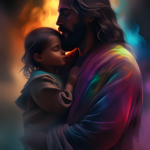Exodus 38, Jesus and Messianic Prophecy: Exploring the Connection
Overview of the Significance of Exodus 38
Exodus 38 holds great significance in understanding the connection between Jesus and Messianic Prophecy. This chapter describes the inventory and completion of the tabernacle, a portable sanctuary that served as a dwelling place for God among the Israelites. The materials used in the construction of the tabernacle, such as gold, silver, and bronze, hold symbolic meanings that point to Jesus and his work. The completion of the tabernacle signifies the fulfillment of Messianic Prophecy and foreshadows the coming of Jesus.
The tabernacle was a central aspect of the Israelite’s worship and its completion marked a significant milestone in their relationship with God. The detailed instructions for the construction of the tabernacle were given by God to Moses on Mount Sinai. The meticulousness with which the tabernacle was built and the materials used in its construction reflect the importance and reverence the Israelites had for their God.
The materials used in the construction of the tabernacle, such as gold, silver, and bronze, were of great value and carried symbolic meanings. Gold, being a precious metal, symbolized divinity and royalty. It represented the holiness and majesty of God. Silver, on the other hand, symbolized redemption and purity. It represented the price that was paid for the redemption of humanity. Bronze, a strong and durable metal, symbolized judgment. It represented the righteous judgment of God. These symbolic meanings of the materials used in the tabernacle point to Jesus and the work he would accomplish as the Messiah.
I. Exodus 36 and Messianic Prophecy: A Closer Look
The story of Exodus in the Bible holds significant messianic implications that were later fulfilled through the life of Jesus. In Exodus 36, we see the construction of the tabernacle, which was a portable sanctuary that served as a dwelling place for God among the Israelites. This tabernacle and the events surrounding it can be seen as a messianic prophecy, foreshadowing the coming of Jesus.
Identification of at least 12 Exodus events later understood to be messianic prophecies further strengthens the connection between Exodus 36 and messianic prophecy. These events include hiding from Pharaoh, being called out of Egypt, the Passover memorial, baptism into Moses at the Red Sea, receiving manna from heaven, water from the rock, fasting for 40 days on Mount Sinai, having a radiant face, being aliens in Kadesh for 38 years, interceding for the people, healing through a serpent on a pole, being a forerunner into Canaan, and crossing the Jordan as a symbol of Canaan rest.
Each of these events in the Exodus narrative holds significant symbolism and points to the future fulfillment of Messianic Prophecy through Jesus. For example, the event of hiding from Pharaoh can be seen as a foreshadowing of Jesus being hidden from Herod as a child. Similarly, the Passover memorial, which commemorates the liberation of the Israelites from slavery, finds its ultimate fulfillment in Jesus as the Passover Lamb who sacrificed himself for the redemption of humanity.
Jesus himself recognized the messianic typology of the Exodus story and drew on it multiple times as messianic prophecy in the gospel of Matthew. This parallel between the New Testament fulfillment and the original Exodus events further strengthens the connection between Exodus 36 and messianic prophecy.
II. Jesus as the Fulfillment of Messianic Prophecy
Jesus is seen as the fulfillment of messianic prophecy in various ways. He fulfilled Old Testament prophecies about the messiah, including his birth in Bethlehem, having a virgin mother, performing miracles, dying for the sins of others, and being resurrected.
Christian interpretation of Old Testament passages as predictions of Jesus is based on their belief in his fulfillment of Scripture. This belief influenced the accounts of Jesus’ life in the Gospels, which highlight the fulfillment of Old Testament prophecies. For example, the Gospel of Matthew emphasizes the fulfillment of messianic prophecy by quoting passages from the Hebrew Scriptures and showing how they were fulfilled in Jesus.
One of the most well-known prophecies about the Messiah is found in Isaiah 53, which describes a suffering servant who will bear the sins of others. Christians believe that Jesus fulfilled this prophecy through his crucifixion, where he took upon himself the sins of humanity and provided salvation through his sacrifice.
However, most Jews reject the claim that Jesus was the messiah based on Old Testament prophecies. There are differing interpretations of Messianic Prophecy between Christians and Jews. Jews do not see the passages that Christians point to as messianic prophecies explicitly mentioning the messiah. They also have historical and theological reasons for rejecting Jesus as the messiah, including the crucifixion of Jesus, which goes against their understanding of what the messiah would do.
III. The Importance of the Torah in Understanding Messianic Prophecy
The Torah, the first five books of the Hebrew Bible, plays a crucial role in interpreting and understanding Messianic Prophecy. It provides a foundation for recognizing Jesus as the fulfillment of prophecy. Specific references in the Torah point to Jesus as the Messiah, and studying the Torah deepens our understanding of Jesus’ role in fulfilling Messianic Prophecy.
For example, in Genesis 3:15, God promises that the offspring of the woman will crush the head of the serpent. This prophecy is understood by Christians to refer to Jesus, who defeated the power of sin and death through his crucifixion and resurrection.
The Torah also contains prophecies about the coming of a prophet like Moses (Deuteronomy 18:15), a descendant of David who will establish an eternal kingdom (2 Samuel 7:12-16), and a suffering servant who will bear the sins of others (Isaiah 53). Christians believe that Jesus fulfills these prophecies, and knowledge of the Torah enhances our comprehension of Messianic Prophecy.
The Torah serves as the foundation for Jewish beliefs and practices, and its significance cannot be overstated in Jewish theology. It contains the commandments and laws that govern Jewish life and serves as a guide for moral and ethical behavior. The study of the Torah is central to Jewish education and religious observance.
IV. Messianic Exodus Events in Moses and Israel
Thirteen Messianic Exodus events in Moses and Israel further illustrate the connection between Exodus and Messianic Prophecy. These events include hiding from Pharaoh, being called out of Egypt, the Passover memorial, being baptized into Moses at the Red Sea, receiving manna from heaven, water from the rock, fasting for 40 days on Mount Sinai, having a radiant face, being aliens in Kadesh for 38 years, interceding for the people, healing through a serpent on a pole, being a forerunner into Canaan, and crossing the Jordan as a symbol of Canaan rest.
Each of these events holds significant symbolism and foreshadows the coming of Jesus and the establishment of the Church. For example, the Israelites hiding from Pharaoh can be seen as a foreshadowing of Jesus being hidden from Herod as a child. The Passover memorial, which commemorates the liberation of the Israelites from slavery, finds its fulfillment in Jesus as the ultimate Passover Lamb who sacrificed himself for the redemption of humanity.
Jesus, in his ministry, fulfilled many of these Messianic Exodus events. His baptism by John the Baptist can be seen as a parallel to the Israelites being baptized into Moses at the Red Sea. The feeding of the five thousand with five loaves and two fish can be compared to the Israelites receiving manna from heaven. These parallels further strengthen the connection between the Exodus events and the fulfillment of Messianic Prophecy through Jesus.
V. Messianic Fulfillments in Jesus and the Church
Thirteen Messianic fulfillments in Jesus and the Church further establish the connection between Exodus and Messianic Prophecy. These fulfillments include being hidden from Herod, being called out of Egypt, the communion memorial, being baptized into Christ, parallels with grumbling and manna, being the rock and water of eternal life, fasting 40 days in the wilderness, having a radiant appearance on the mountain, being aliens in the Church, interceding for believers, healing through the cross, being a forerunner into heaven, and finding rest in heaven.
Each of these fulfillments in the life of Jesus and the Church mirrors the original Exodus events and deepens our understanding of Jesus’ role as the Messiah. For example, just as the Israelites grumbled and received manna from heaven, Jesus provides spiritual nourishment to believers through his teachings and the gift of the Holy Spirit. Additionally, just as the Israelites found rest in the Promised Land, believers find rest in the eternal kingdom of heaven through their faith in Jesus.
The Church, as the body of Christ, continues to participate in the fulfillment of Messianic Prophecy. Through the sacraments, such as communion, believers remember and participate in the work of Jesus. The Church also continues Jesus’ intercession for believers, praying on their behalf and bringing their needs before God.
VI. The Inventory and Completion of the Tabernacle
Exodus 38 describes the inventory and completion of the tabernacle, which holds symbolic significance in Messianic Prophecy. The materials used in the construction of the tabernacle, such as gold, silver, and bronze, carry symbolic meanings. Gold represents divinity and royalty, silver symbolizes redemption and purity, and bronze signifies judgment. These materials point to Jesus and his work as the Messiah.
The inventory and completion of the tabernacle were essential steps in the establishment of the Israelite’s worship system. The tabernacle served as a physical representation of God’s presence among the Israelites and a place for them to offer sacrifices and worship. The meticulous record-keeping of the materials used in the tabernacle’s construction reflects the importance placed on the proper execution of God’s instructions.
The completion of the tabernacle was a momentous occasion for the Israelites. It marked the culmination of their efforts and the fulfillment of God’s plan for a dwelling place among his people. The completion of the tabernacle signified the fulfillment of Messianic Prophecy. It foreshadowed the coming of Jesus, who would fulfill the role of the tabernacle as the dwelling place of God among humanity.
VII. The Symbolism and Meaning of the Courtyard of the Sanctuary
The courtyard of the sanctuary in Exodus holds deep symbolism and meaning, providing insights into Messianic Prophecy. The courtyard was visible to anyone who passed by, attracting attention and making people curious about the sanctuary. It represented order, harmony, diversity, sacrifice, and forgiveness.
The courtyard served as a physical and symbolic boundary, separating the holy space of the tabernacle from the outside world. It represented the distinction between the sacred and the profane. The courtyard was a place of preparation and transition, where the Israelites would bring their offerings and cleanse themselves before entering the tabernacle itself.
The courtyard revealed God’s attributes of love, justice, mercy, compassion, righteousness, and holiness. Through the courtyard, believers are reminded to reflect these attributes to others and lead them to Christ. The courtyard also serves as a reminder that believers are temples of God, and just as the courtyard was a place of encounter with God, believers are called to be a place where others can encounter God’s presence.
VIII. Understanding the Rejection of Jesus as the Messiah
The rejection of Jesus as the messiah by most Jews is rooted in the interpretation of Old Testament prophecies and historical and theological factors. While Christians interpret Old Testament passages as predictions of Jesus, Jews do not see these passages explicitly mentioning the messiah. They have differing interpretations of Messianic Prophecy and reject Jesus based on their understanding of the messianic role.
Historical factors, such as the crucifixion of Jesus, have also contributed to the rejection of Jesus as the messiah by Jews. The crucifixion goes against their understanding of what the messiah would do, and it is seen as a stumbling block to accepting Jesus as the fulfillment of Messianic Prophecy.
Despite the rejection of Jesus by most Jews, the connection between Exodus 38, Jesus, and Messianic Prophecy remains significant in understanding the fulfillment of God’s plan through Jesus. The parallels between the Exodus events and the life of Jesus, as well as the symbolic significance of the tabernacle and the courtyard, provide compelling evidence for the fulfillment of Messianic Prophecy in Jesus. The exploration of these connections deepens our understanding of the significance of Exodus 38 and its role in pointing to Jesus as the fulfillment of Messianic Prophecy.
#Exodus38 #Jesus #MessianicProphecy #OldTestament #BiblicalInterpretation #ReligiousSymbolism #DivineFulfillment #RedemptiveWork #MessiahFulfillment #BiblicalProphecies #FaithAndBelief #ReligiousUnderstanding


